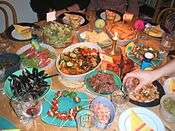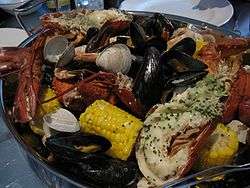Cuisine
A cuisine (/kwɪˈziːn/ kwi-ZEEN; from French [kɥizin], in turn from Latin coquere "to cook") is a style of cooking characterized by distinctive ingredients, techniques and dishes, and usually associated with a specific culture or geographic region.[1][2][3] A cuisine is primarily influenced by the ingredients that are available locally or through trade. Religious food laws, such as Hindu, Islamic and Jewish dietary laws, can also exercise a strong influence on cuisine. Regional food preparation traditions, customs and ingredients often combine to create dishes unique to a particular region.[4]
Factors that affect a cuisine
Some of the elements that have an influence on a region's cuisine include the area's climate, which in large measure determines the native foods that are available, the economic conditions, which affect trade and can affect food distribution, imports and exports, and religiousness or sumptuary laws, under which certain foods and food preparations are required or proscribed.
Climate also affects the supply of fuel for cooking; a common Chinese food preparation method was cutting food into small pieces to cook foods quickly and conserve scarce firewood and charcoal. Foods preserved for winter consumption by smoking, curing, and pickling have remained significant in world cuisines for their altered gustatory properties even when these preserving techniques are no longer strictly necessary to the maintenance of an adequate food supply.
History
Cuisine dates back to the Antiquity. Rome was known for its cuisine, wealthy families would dine in the Triclinium on a variety of dishes, their diet consisted of eggs, cheese, bread, meat and honey.
New cuisines

Cuisines evolve continually, and new cuisines are created by innovation and cultural interaction. One recent example is fusion cuisine, which combines elements of various culinary traditions while not being categorized per any one cuisine style, and generally refers to the innovations in many contemporary restaurant cuisines since the 1970s.[5] Nouvelle cuisine (New cuisine) is an approach to cooking and food presentation in French cuisine that was popularized in the 1960s by the food critics Henri Gault, who invented the phrase, and his colleagues André Gayot and Christian Millau in a new restaurant guide, the Gault-Millau, or Le Nouveau Guide.
Global cuisine
A global cuisine is a cuisine that is practiced around the world, and can be categorized according to the common use of major foodstuffs, including grains, produce and cooking fats.
Regional cuisines
Regional cuisines may vary based upon food availability and trade, cooking traditions and practices, and cultural differences.[3] For example, in Central and South America, corn (maize), both fresh and dried, is a staple food. In northern Europe, wheat, rye, and fats of animal origin predominate, while in southern Europe olive oil is ubiquitous and rice is more prevalent. In Italy the cuisine of the north, featuring butter and rice, stands in contrast to that of the south, with its wheat pasta and olive oil. China likewise can be divided into rice regions and noodle & bread regions. Throughout the Middle East and Mediterranean there is a common thread marking the use of lamb, olive oil, lemons, peppers, and rice. The vegetarianism practiced in much of India has made pulses (crops harvested solely for the dry seed) such as chickpeas and lentils as significant as wheat or rice. From India to Indonesia the use of spices is characteristic; coconuts and seafood are used throughout the region both as foodstuffs and as seasonings.
African cuisine

African cuisines use a combination of locally available fruits, cereal grains and vegetables, as well as milk and meat products. In some parts of the continent, the traditional diet features a preponderance of milk, curd and whey products. In much of tropical Africa, however, cow's milk is rare and cannot be produced locally (owing to various diseases that affect livestock). The continent's diverse demographic makeup is reflected in the many different eating and drinking habits, dishes, and preparation techniques of its manifold populations.[6]
-

Typical Ethiopian and Eritrean cuisine: Injera (pancake-like bread) and several kinds of wat (stew)
-
Yassa is a popular dish throughout West Africa prepared with chicken or fish. Chicken yassa is pictured.
Asian cuisine

Asian cuisines are many and varied. Ingredients common to many cultures in the east and Southeast regions of the continent include rice, ginger, garlic, sesame seeds, chilies, dried onions, soy, and tofu. Stir frying, steaming, and deep frying are common cooking methods. While rice is common to most Asian cuisines, different varieties are popular in the various regions; Basmati rice is popular in the subcontinent, Jasmine is often found across the southeast, while long-grain rice is popular in China and short-grain in Japan and Korea.[7] Curry is also a common dish found in southern and eastern Asia, however they are not as popular in western Asian cuisines. Those curry dishes with origins in India and other South Asian countries usually have a yogurt base while Southeastern and Eastern curries generally use coconut milk as their foundation.[8]
-

A market stall at Thanin market in Chiang Mai, Thailand selling ready cooked food
-

Due to Guangdong's location on the southern coast of China, fresh live seafood is a specialty in Cantonese cuisine.
-

A Tajik feast
-

Typical Assyrian cuisine
European cuisine

European cuisine (alternatively, "Western cuisine") include the cuisines of Europe and other Western countries. European cuisine includes that of Europe and to some extent Russia, as well as non-indigenous cuisines of North America, Australasia, Oceania, and Latin America. The term is used by East Asians to contrast with Asian styles of cooking.[9] This is analogous to Westerners referring collectively to the cuisines of Asian countries as Asian cuisine. When used by Westerners, the term may refer more specifically to cuisine in Europe; in this context, a synonym is Continental cuisine, especially in British English.
-

An English Sunday roast with roast beef, roast potatoes, vegetables and Yorkshire pudding
-

A variety of tapas: appetizers or snacks in Spanish cuisine
Oceanian cuisine

Oceanian cuisines include Australian cuisine, New Zealand cuisine, Tasmanian cuisine, and the cuisines from many other islands or island groups throughout Oceania.
-

Bush Tucker (bush foods) harvested at Alice Springs Desert Park in Australia
-

A Hāngi being prepared, a New Zealand Māori method of cooking food for special occasions using hot rocks buried in a pit oven.
Cuisines of the Americas
.svg.png)
The cuisines of the Americas are found across North and South America are based on the cuisines of the countries from which the immigrant peoples came, primarily Europe. However, the traditional European cuisine has been adapted by the addition of many local ingredients, and many techniques have been added to the tradition as well. In the case of Latin American cuisines, many pre-Columbian ingredients and techniques are still used. The regional cuisines are Canadian cuisine, American cuisine, Mexican cuisine, Central American cuisine, South American cuisine, and Caribbean cuisine.
-

Québécois poutine is made with french fries, curds and gravy.
-
A sirloin steak dinner
See also
| |
|
|
| Food | Drink | Wine |
| |
|
|
| Beer | Coffee | Bacon |
| | ||
| Culture |
References
- ↑ "Cuisine." Thefreedictionary.com. Accessed June 2011.
- ↑ Cuisine [def. 1]. (2014). Oxford English Dictionary Online. Retrieved 11 March 2015, from http://www.oed.com/view/Entry/45611
- 1 2 "The American Food Revolutions: Cuisines in America." Eldrbarry.net. Accessed June 2011.
- ↑ "Rediscover the flavors and traditions of true American cuisine!" Whatscookingamerica.net. Accessed June 2011.
- ↑ Lindsey, Robert (18 August 1985). "California Grows Her Own Cuisine.". New York Times.
- ↑ Bea Sandler (1993). The African Cookbook. Diane and Leo Dillon (Illust.). Carol Publishing Group. ISBN 0-8065-1398-5. Retrieved 2008-12-18.
- ↑ "The flavors of Asia". Quaker Oats Company. Archived from the original on 4 June 2007. Retrieved 2008-12-19.
- ↑ "Cuisine Areas Of Asia". Kraft Foods (Australia). 2007. Retrieved 2008-12-20.
- ↑ Leung Man-tao (12 February 2007), "Eating and Cultural Stereotypes", Eat and Travel Weekly, no. 312, p. 76. Hong Kong
Further reading
- Albala, Ken (2011). Food Cultures of the World Encyclopedia Greenwood. ISBN 978-0-313-37626-9
- California Culinary Academy (2001). In the World Kitchen: Global Cuisine from California Culinary Academy. Bay Books (CA). ISBN 1-57959-506-5.
- Laudan, Rachel (2013). Cuisine and Empire: Cooking in World History University of California Press. ISBN 978-0-520-26645-2
- MacVeigh, Jeremy (2008). International Cuisine. Delmar Cengage Learning; 1st edition. ISBN 1-4180-4965-4.
- Nenes, Michael F; Robbins, Joe (2008). International Cuisine. Hoboken, N.J.: Wiley, John & Sons; 1st edition. ISBN 0-470-05240-6.
- Scarparto, Rosario (2000). New global cuisine: the perspective of postmodern gastronomy studies. Royal Melbourne Institute of Technology.
- Zobel, Myron (1962). Global cuisine: being the unique recipes of the 84 top restaurants of the world. Patron Press.
External links
- Wikibooks Cookbook
- The Elizabeth Robins Pennell Collection at the Library of Congress has many volumes on the topic of cuisine.
| ||||||
|




